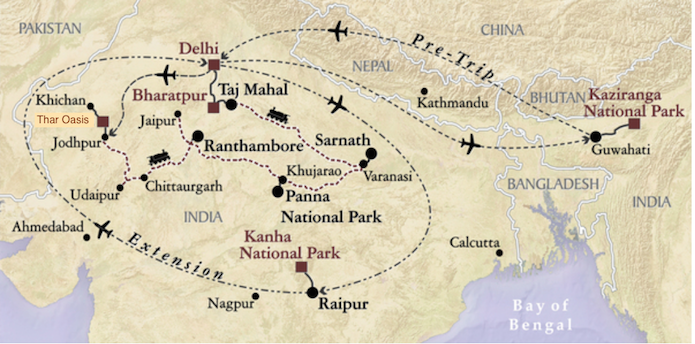
Today we drove from the Thar Oasis to Jodhpur and explored Jodhpur before boarding our train
(Image courtesy of VENT)
(Click on images to enlarge)

| Lee and I woke quite early this morning in our tent in the Thar Desert and stepped out to savor the desert dawn. Once we were packed, we walked around the camp in the early morning stillness. (Well, it was still except for the shrieks of the Peafowl.) We could see a small settlement in the distance. |
|
Dawn in the Thar Desert |
Thar Desert settlement |
| We were soon settled in the bus for the long drive back to Jodhpur over single-lane roads, which meant a lot of honking and swerving off the road. Our first stop was impromptu; one of the guides spotted a Red-necked Falcon, but it was a while before the driver in his glass case noticed we were trying to get him to stop. We set up scopes not far from the bus, wanting to be sure everybody got a look at this very good bird (Dion has seen it only five times) before it got spooked. Once we had the scope on it, we could see that there were actually a pair of them, one with its back to us and one facing us. What a treat! This is the bird I most wanted to see on this trip. We were able to get much closer and get good looks at the birds before they left their perches to hunt, which allowed us to see more behavior as the two of them operated in tandem, going after a lapwing and then a dove. |
|
Driving in the Thar Desert |
Red-necked Falcon |
|
|
As we drove along, Lee noted a sign for the
Gramin Bank (“Bank
of the Villages”) that has helped some of India’s poorest people
lift themselves out of poverty through micro-credit.
We were glad to see many children, both boys and girls, on their way to school, but we all gasped to see school children climbing down from the roof of the public bus that was their transport to school. Another sight along the road was a series of massive quarries for the region’s famous sandstone. We passed the plants for processing the stone and even a shop that specialized in the big circular saw blades that are used to cut it. |
| The bus was able to take us part of the way up the hill, where we found ourselves before one of the fort’s seven gates and a wall with paintings of scenes from Indian tradition. |
|
Entrance to Mehrangarh Fort |
 Ganesha represented in wall painting |
| We spent the next two hours exploring the fort. It was a stunning. My strongest impression was of the intricately carved stone: |
|
|

|
| The fort has a remarkable museum of the treasures of the Maharajas. This silver howdah was a gift from Emperor Shah Jahan to the Maharaja of that era: |
|
Silver howdah of Jaswant Singh I |
(A gift from Emperor Shah Jahan) |
| There were many more howdahs and palanquins exhibiting extraordinary craftsmanship (and oneupsmanship). There was even a room devoted to the cradles of future maharajas. |
 Detail of maharaja’s cradle |
| There was also a nice exhibit of Marwar paintings; I loved one from around 1730 that portrayed a garden with Sarus Cranes in it. |
 Detail of Marwar painting with Sarus Crane |
|
Being us, we also found the time to enjoy the wildlife of the fort. The air was
filled with Little Swifts, and it was nifty to be able to look down upon them in
flight and to see them zipping into and out of their nests on the palace
ceilings. We enjoyed the occasional flyover of a Griffin Vulture and got a look
at a much rarer Indian (Long-billed) Vulture. We were amused to see the little
Five-striped Palm Squirrels scampering up and down the stone facades as though
they were trees, particularly in light of the sign that had told us that the
Marwar artists had used squirrel hair for their brushes.
When we had seen as much as we could, we drove a short way to the 1899 mausoleum for the maharajas. Having noticed it in the distance from the fort, I had dismissed it as white marble Victorian kitsch, but the drive there gave us a chance to see more of the magnificent wall of the fort, as well as the somewhat bizarre equestrian statue of the last ruling Maharaja of Jodhpur (which instantly reminded Lee and me both of the big statue of Genghis Khan in Ulaan Baatar). Fortunately, there was a lake by the mausoleum and it had some really good birds, including another male Ferruginous Duck, a couple of dozen swimming Ruffs (looking like phalaropes), and an Indian Pond Heron, a much better look than we had a few days ago, as well as a male Common Pochard, very handsome. When it came time to climb up the steps to go to the mausoleum, I opted not to bother and just watched the birds. |
|
Maharaja Man Singh II |
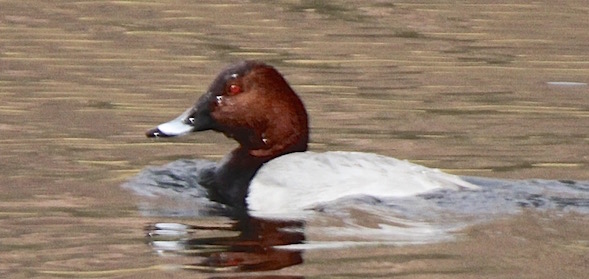 Common Pochard (Image courtesy of Amy Sheldon) |
|
Ajit Bawan |
Leaving the mausoleum, we had a long drive through city traffic to return to Ajit Bawan, the maharaja’s residence where we had lunch a few days ago. This time, I chose raita, a very nice spicy eggplant dish, rice, and naan and then went back to get four gulab jamuns (my favorite dessert in the world that isn’t chocolate—they were really good). Dion sat at our table and we had a pleasant chat with him. |
| We had time for some birding in the garden after lunch and were happy finally to identify a pair of Common Tailorbirds who’d been calling from inside some very heavy foliage but at last came out into the open. Stephanie helped us confirm the ID. We would have loved to see their nest, but it was the wrong time of the year. Tailorbirds get their name from the way in which they sew their nest from leaves, piercing the leaves and pulling a fiber through the holes to tie the leaves together (leaving the white tufts you can see in the photos below). |
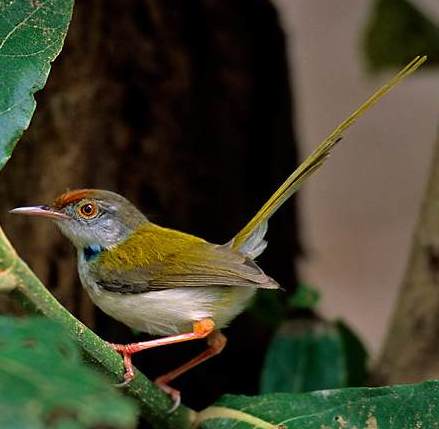 Common Tailorbird (Image courtesy of Wikimedia Commons) |
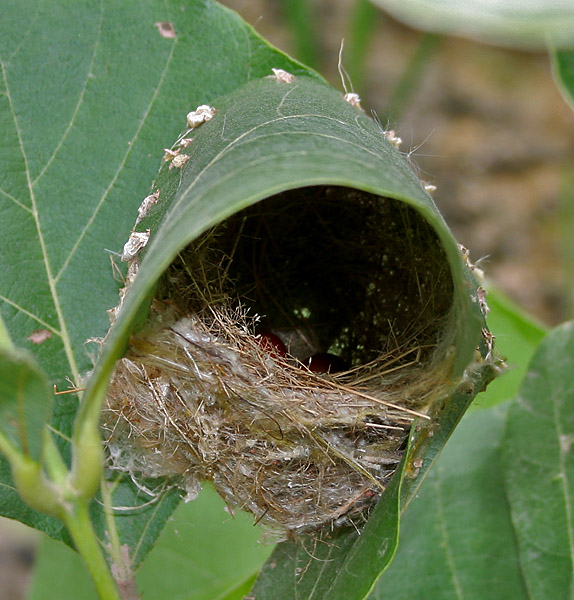 Common Tailorbird nest (Image courtesy of Wikimedia Commons) |
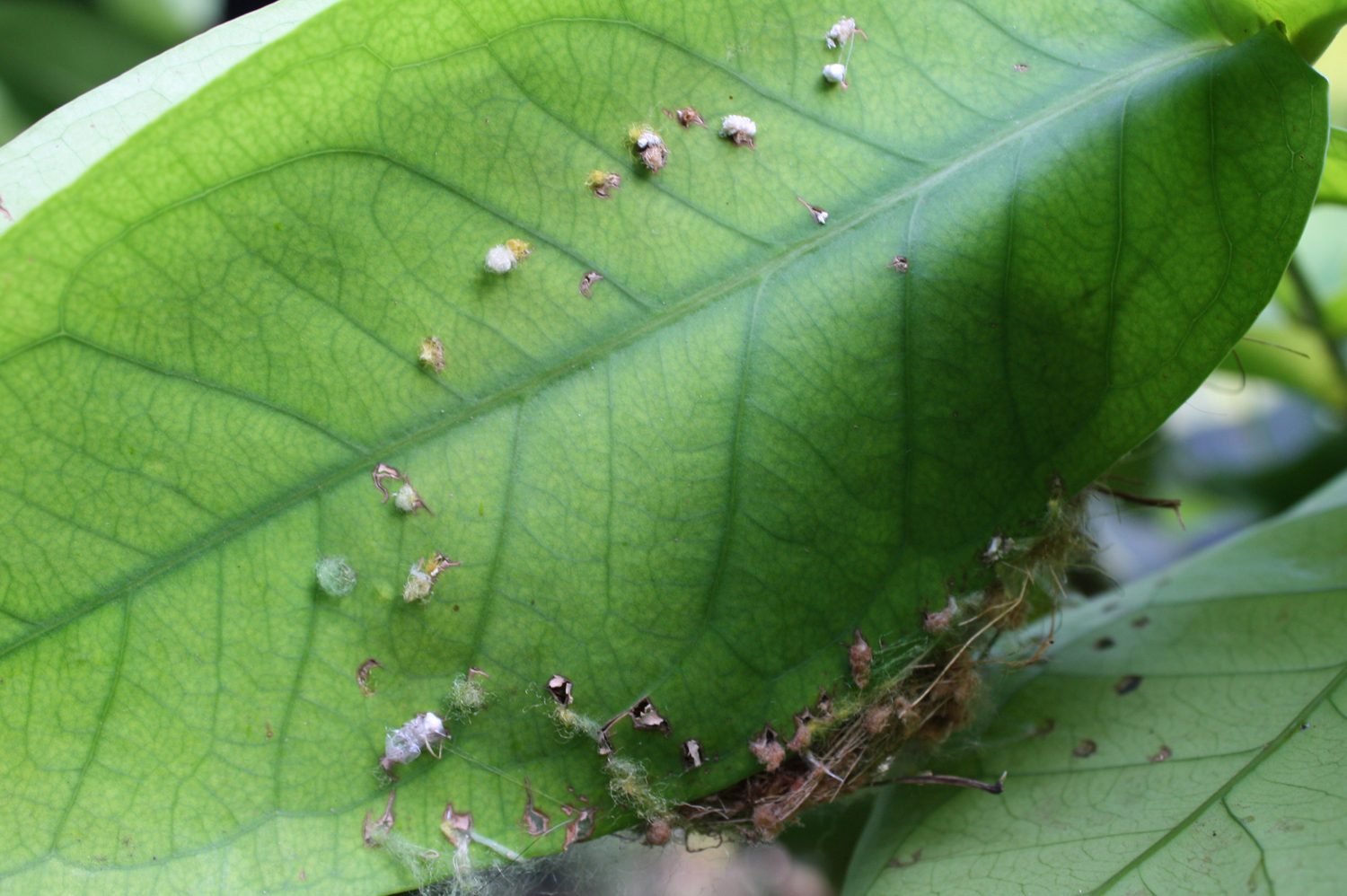 Nest from above (Image courtesy of Wikimedia Commons) |
| It wasn’t far from the restaurant to the train station where we were to join the Royal Rajasthan on Wheels. We were met at the bus by our coach steward, Keith Murray, and his assistant and led to our stateroom. Our compartment is very nice, with two real beds and a large bathroom. There are only three staterooms per rail car, so the size is quite generous. The appointments are elegant if perhaps a bit threadbare. Once we figured out that our emptied suitcases would fit under the beds and didn’t have to go into the closets, all was well. We are settled in for the next five nights. |
|
Our steward, Keith Murray |
Aboard the Royal Rajasthan on Wheels |
| Before the train departed, Lee went out to grab some more “train porn” photos, while I started catching up on my journals. (Yes, she still uses vi and a black screen with green characters.) |
|
Shortly before 7, Keith reminded us that it was almost time for our dinner and
told us that he would guide us to the dining car. We were both surprised to see
that the join between the cars is carpeted, not a touch one sees on New Jersey
Transit. Our group has a whole dining car to itself. Once everybody was there,
we did the checklist for the day and got our instructions for tomorrow. Lee and
I sat down at a table for four and were pleased when Sally and Charlie joined
us there. The meal was rather overwhelming. We’d assumed we could
choose between the continental and Indian menus, but in fact, they just brought
us everything from both menus. The Indian sweet was another gulab jamun, but
shaped like a sausage, which just didn’t seem right. We thoroughly
enjoyed talking with Sally and Charlie and stayed up past my bedtime.
For the past few days, Lee has had a dry cough that we both attributed to the air pollution in Delhi, but late today it became much deeper. I filled him with cold remedies before we went to bed, which seemed to cut his cough enough for him to sleep. It’s presumably something he picked up on one of our flights or on the Tube. Drat! My birds for the day: |
| Comb Duck | Gadwall | Eurasian Wigeon | Indian Spot-billed Duck | Northern Pintail |
| Green-winged Teal | Common Pochard | Ferruginous Duck | Grey Francolin | Indian Peafowl |
| Little Grebe | Greater Flamingo | Great Cormorant | Little Cormorant | Grey Heron |
| Intermediate Egret | Eastern Cattle Egret | Indian Pond Heron | Black-shouldered Kite | Egyptian Vulture |
| Indian Vulture | Griffon Vulture | Steppe Eagle | Black Kite | Common Moorhen |
| Eurasian Coot | Black-winged Stilt | Red-wattled Lapwing | Spotted Redshank | Ruff |
| Rock Pigeon | Eurasian Collared Dove | Laughing Dove | Asian Koel | Spotted Owlet |
| Little Swift | Green Bee-eater | Eurasian Hoopoe | Red-necked Falcon | Rose-ringed Parakeet |
| Isabelline Shrike | Southern Grey Shrike | Black Drongo | House Crow | Red-vented Bulbul |
| White-eared Bulbul | Common Tailorbird | Variable Wheatear | Bank Myna | Common Myna |
| Brahminy Starling | Rosy Starling | House Sparrow |

